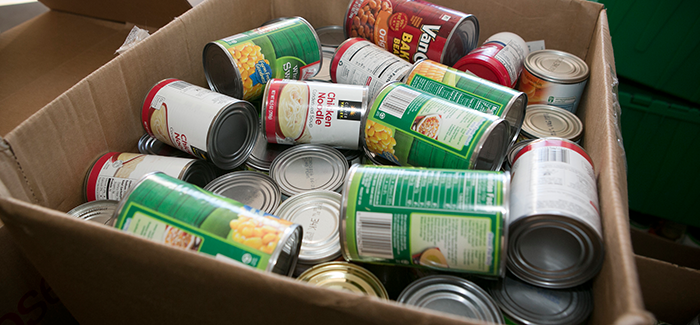
(Photography by Jeff Helsel, CC BY-NC-SA 2.0)
Food pantry director Jan Deckenbach shares ways to provide comfort to your neighbors with the greatest need.
This time of the month the lines for food are always long. Not only in grocery stores bustling with people making last minute Thanksgiving purchases but also at food pantries. “Generally more people come at the end of any given month,” says Jan Deckenbach, AM’77, the Hyde Park and Kenwood Hunger Programs’ community food pantry director.
The food pantry has been open every single Saturday from 10 a.m. to 1 p.m. since it started in 1981. Each month the program provides 300 to 850 people with emergency groceries, 35 percent 18 years old or younger and 26 percent 60 or older.
Since 2002 the food pantry has been running out of the Hyde Park Union Church. Deckenbach, who works full-time as an assistant paperback editor at the University of Chicago Press, is there most Saturdays herself, helping to feed the neighborhood’s hungry.
Through her 32 years of volunteering at the pantry, she has learned a lot about how help the hungry, including the most effective way: “Donate money.” The reason? Unless you’re buying food by the case, either from a wholesaler/discount outlet or directly from a farmer, you won’t be able to beat the prices a food pantry can get.
In an interview with the Magazine, edited and adapted below, Deckenbach talks more about her work feeding the hungry.
How does the food pantry work?
We give out groceries—our main mission—and we also have a case manager available for people to consult about other problems. To get food, people sign in; we serve them in the order in which they sign in. Once their names are called they sign the federal paperwork which includes their address and household size as part of the government auditing of the food. We have the food out on tables, for the most part, and the recipients walk through to choose their food. Quantities of some items are limited, and volunteers explain all that to recipients as they walk by the items.
How common is hunger in Hyde Park and Kenwood?
Housing prices in this area are high, so many residents are making it only as long as no one in the house loses a job, gets sick, has a car problem, or has a legal problem. It’s a very delicate balancing act that one piece of bad luck can send tumbling down. Some area residents who receive SNAP benefits have had them cut recently—sometimes drastically—to as low as $16 per month. And we see quite a few senior citizens on fixed incomes.
How can people donate goods to the food pantry?
We prefer donations of money and of personal hygiene products. Don’t raid your cupboards; ask the food pantry what they want. In our area, people often buy special food supplies thinking that they’re going to learn to cook ethnic food or will need extra food for religious holidays. No recipient at our pantry ever wants gefilte fish, coconut milk, miso, bamboo shoots, or water chestnuts.
What are some of the most needed hygiene products?
Soap, shampoo, toothpaste, toothbrushes, deodorant, and tampons.
Where does the food pantry get most of the food it distributes?
We are a member agency of the Greater Chicago Food Depository and get most of our food from them. Some of it is free from the government, some of it is free from the depository, and some of it is purchased from the depository at a subsidized price. We also order food through Hyde Park Produce when we can’t get enough key items from the depository.
What are some things that most people don’t realize about people who get foods from food pantries?
Our folks tend toward hypertension and diabetes, so low-sodium and high-protein items are always a plus. We try to avoid food made with high-fructose corn syrup whenever possible. We like pop-top cans of tuna and other protein for our homeless folks. People don’t mind organic food, but we have very few takers for whole-wheat pasta.
Volunteers—do you need them? If so, how can people help out?
We have a lot of offers to volunteer on Saturdays, overwhelmingly so at the holidays. Summers are when we tend to need volunteers the most.
To learn more about the food pantry and the Hyde Park and Kenwood Hunger Programs, including information on volunteering and how make a donation, please visit their website.
